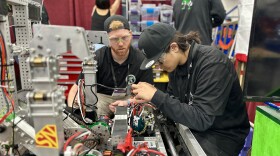When Randall Christison was a child, he was sick with whooping cough and knew a boy down the street who died from the measles.
This was the reality of American life before vaccines. It’s a reality he doesn’t want his country to revisit.
“Any person who does not vaccinate his or her children is just engaging in child abuse,” said Christison, a 71-year-old semi-retired litigator in downtown San Diego.
The problem, say immunologists, is that voices like Christison’s are growing fainter. They’re being drowned out by the opinions of younger parents who grew up in an era without such epidemics.
The horrors that vaccine-preventable diseases like measles and polio once visited upon large swaths of the American populace are nearly forgotten. There once was a near-unanimous belief that the infinitesimally small risk vaccines posed was far preferable to the enormous risk these diseases posed. That belief has now been replaced by a debate over whether those vaccines’ risks are worth preventing near invisible diseases.
And the conversation is front and center nationally, as measles, mumps and whooping cough make a resurgence.
Nearly 51,000 California kindergarteners — in both public and private schools— began the 2014-2015 school year lacking one or more recommended vaccinations against diseases such as measles, polio and whooping cough, according to an inewsource analysis of data from the California Department of Public Health.
That’s 9.5 percent of the statewide kindergarten class. That figure represents a decline from last school year’s 9.8 percent but a rise from the 7 percent rate a decade ago.
Those figures and trends mirror those for San Diego County’s kindergartens, as inewsource reported previously.
INTERACTIVE: Click here for a map of kindergarten vaccination rates in San Diego County
Of the 51,000 kindergarteners who weren’t up-to-date on their vaccines, more than a quarter had personal belief exemptions — the opt-out parents can sign against immunizing their school-age children. The remainder of under-vaccinated children either had immune systems too weak for vaccines or were behind on vaccinations.
Dr. Shane Crotty, a professor at the La Jolla Institute for Allergy & Immunology, said a parent’s decision to vaccinate her or his child is largely motivated by fear.
“It really comes down to two fears the fear of something happening if you get vaccinated versus the fear of something happening if you don’t get vaccinated,” Crotty said.
Victims Of Their Own Success

Diseases such as measles and polio were once common in the United States, killing thousands every year.
Severe illness and death from these diseases was a fact of life for those who grew up in the 1950s, said Christison, who recalled a months-long bout with whooping cough.
“I had that in eighth grade. It was the kind of disease that comes and goes," Christison said. “The good days you feel just bad and the bad days you’re wondering if you’re going to stay alive.”
He knew a 12-year-old boy on his street who died from the measles. His cousin got them when she was pregnant and gave birth to a daughter with severe developmental disabilities.
It was only 50 or so years ago, as vaccines began to be deployed, that rates of these diseases began to see real reductions — eventually to nothing or nearly nothing.
This is an irony not lost on Crotty, an expert in immunology.
“Absolutely, vaccines are a victim of their own success and that’s been true ever since there have been successful vaccines,” Crotty said.
A Pew Research Center survey conducted in August found that young adults were more likely to believe that the decision to vaccinate children should be left in the hands of parents and not mandated by law.
Forty-one percent of those surveyed between the ages of 18 and 29 said parents should decide compared with 20 percent of those 65 or older.
In California, two state lawmakers said last week that they would introduce legislation to do away with the personal belief exemption — including for religious reasons. Currently, only Mississippi and West Virginia permit neither religious nor philosophical exemptions to its vaccination program.

Dr. Wilma Wooten, San Diego County's public health officer, has volunteered in Africa on medical missions where mothers are eager to have their children immunized.
What’s responsible for the different attitudes? Personal experience.
“Because they’ve seen the devastation that not being vaccinated causes, the deaths associated with getting infected and the loss of their children,” Wooten said. “We haven’t seen that in recent history in the United States.”







